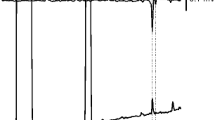Abstract
Calling behavior and pheromone emission by virgin femaleE. loftini moths were investigated in laboratory experiments. Calling peaked during the last three hours of the night. Three-day-old moths called more than older or younger moths and began calling earlier in the night than younger moths. Female emissions were collected in flasks without airflow and cylinders with airflow. Control tests indicated that the pheromone components (Z)-11-hexadecenyl acetate (HDA) and (Z)-13-octadecenylacetate (ODA) were 69 and 54% adsorbed on moths, respectively, and the component (Z)-13-octadecenal (ODL) was 92–99% adsorbed depending on its concentration, when put into flasks with noncalling females for 4 hr. Pheromone exposed to moths for less than 4 hr was adsorbed less. After correction for adsorption, the pheromone blend from females calling in flasks was 9:42:49% of HDA/ODL/ODA with an overall emission rate of 58 ng/female/4 hr. Three-day-old females emitted more pheromone than 0- to 2- or 4- to 5-day-old moths, in flasks. Little or no pheromone put into cylinders either downwind or upwind from a male moth was adsorbed by the moth. The pheromone blends from females calling in cylinders, corrected using downwind and upwind control test results, respectively, were 15:35:50 and 13:40:48% of HDA/ODL/ODA with overall emission rates of 32 and 35 ng/female/night.
Similar content being viewed by others
References
Baker, T.C., Cardé, R.T., andMiller, J.R. 1980. Oriental fruit moth pheromone component emission rates measured after collection by glass-surface adsorption.J. Chem. Ecol. 6:749–757.
Baker, T.C., Gaston, L.K., Mistrot Pope, M., Kuenen, L.P.S. andVetter, R.S. 1981. A high-efficiency collection device for quantifying sex pheromone volatilized from female glands and synthetic sources.J. Chem. Ecol. 7:961–968.
Brown, H.E., Wood, L.T., Shaver, T.N., andWorley, J. 1988. Behavioral responses of maleEoreuma loftini (Lepidoptera: Pyralidae) to ovipositor extracts.J. Econ. Entomol. 81:184–188.
Das, G.P., andIslam, M.A. 1982. Effects of age on the calling behaviour of the Brinjal shoot and fruit borer,Leucinodes orbonalis Guenee (Lepidoptera: Pyralidae).Bangladesh J. Zool. 10:120–125.
Hirai, K. 1982. Mating behavior of the lima bean pod borer,Etiella zinckenella Treitschke (Lepidoptera: Pyralidae).Appl. Entomol. Zool. 17:480–485.
Kaae, R.S., andShorey, H.H. 1972. Sex pheromones of noctuid moths. XXVII. Influence of wind velocity on sex pheromone releasing behavior ofTrichoplusia ni females.Ann. Entomol. Soc. Am. 65:436–440.
Kanno, H. 1979. Effects of age on calling behaviour of the rice stem borer,Chilo suppressalis (Walker) (Lepidoptera: Pyralidae).Bull. Entomol. Res. 69:331–335.
Kanno, H., andSato, A. 1978. Mating behavior of the rice stem borer moth,Chilo suppressalis Walker (Lepidoptera: Pyralidae) I. Effects of moth age on mating activity.Appl. Entomol. Zool. 13:215–221.
Mayer, M.S., andMankin, R.W. 1985. Neurobiology of pheromone perception, pp. 95–144,in G.A. Kerkut and L.I. Gilbert (eds.). Comprehensive Insect Physiology, Biochemistry and Pharmacology, Vol. 9. Pergamon Press, New York.
Nordlund, D.A., andBrady, U.E. 1974. Factors affecting release rate and production of sex pheromone by femalePlodia interpunctella (Hubner) (Lepidoptera: Pyralidae).Environ. Entomol. 3:797–802.
Ramaswamy, S.B., andCardé, R.T. 1984. Rate of release of spruce budworm pheromone from virgin females and synthetic lures.J. Chem. Ecol. 10:1–7.
Shaver, T.N., Brown, H.E., Williams, H.J., Woods, L.T., andWorley, J. 1988. Components of the female sex pheromone ofEoreuma loftini Dyar.J. Chem. Ecol. 14:391–399.
Skoog, D.A., andWest, D.M. 1969. Fundamentals of Analytical Chemistry. Holt, Rinehart and Winston, New York.
Tamaki, Y. 1985. Sex pheromones, pp. 145–191,in G.A. Kerkut and L.I. Gilbert (eds.). Comprehensive Insect Physiology, Biochemistry and Pharmacology, Vol. 9. Pergamon Press, New York.
Tumlinson, J.H., Heath, R.R., andTeal, P.E.A. 1982. Analysis of chemical communication systems of Lepidoptera, pp. 1–25,in B.A. Leonhardt and M. Beroza (eds.). Insect Pheromone Technology: Chemistry and Applications. American Chemical Society, Washington, D.C.
Author information
Authors and Affiliations
Additional information
Lepidoptera: Pyralidae.
Rights and permissions
About this article
Cite this article
Robacker, D.C., Johnson, K.J.R. Pheromone emission and blend percentages inEoreuma loftini determined by two methods. J Chem Ecol 15, 105–120 (1989). https://doi.org/10.1007/BF02027777
Received:
Accepted:
Issue Date:
DOI: https://doi.org/10.1007/BF02027777




